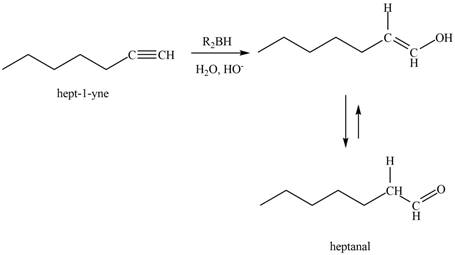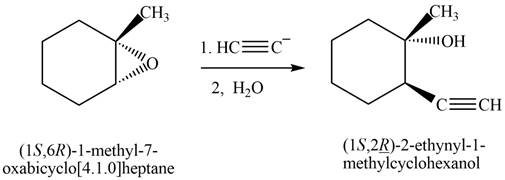
Concept explainers
Draw the organic products formed in each reaction.
a.  f.
f. 
b.  h.
h. 
d.  i.
i. 
e.  j.
j. 
(a)
Interpretation: The product that is formed by the reaction is to be drawn.
Concept introduction: The addition of an electrophile to an alkyne is followed by Markovnikoff’s rule and anti-stereoselectivity.
The addition of a halogen to an alkyne chain leads to the formation of corresponding alkene or alkane. The reaction which includes the addition of bromine atoms to the alkyne chain is known as bromination. Bromination can be done by using the reagents like
Answer to Problem 11.38P
The product that is formed by the reaction is
Explanation of Solution
The reaction of

Figure 1
The reaction of
The product that is formed by the reaction is
(b)
Interpretation: The product that is formed by the reaction is to be drawn.
Concept introduction: The addition of an electrophile to an alkyne is followed by Markovnikoff’s rule and anti-stereoselectivity.
The addition of a halogen to an alkyne chain leads to the formation of corresponding alkene or alkane. The reaction which includes the addition of bromine atoms to the alkyne chain is known as bromination. Bromination can be done by using the reagents like
Answer to Problem 11.38P
The product that is formed by the reaction is
Explanation of Solution
The reaction of

Figure 2
The reaction of
The product that is formed by the reaction is
(c)
Interpretation: The product that is formed by the reaction is to be drawn.
Concept introduction: The addition of a halogen to an alkyne chain leads to the formation of corresponding alkene or alkane. The reaction which includes the addition of bromine atoms to the alkyne chain is known as bromination.
The replacement or substitution of one functional group with another different functional group in any chemical reaction is termed as substitution reaction. The nucleophilic reaction that consists of bimolecular as well as bond-making and bond-breaking steps is termed as
Answer to Problem 11.38P
The product that is formed by the reaction is
Explanation of Solution
The reaction of

Figure 3
The reaction of
The reaction of

Figure 4
The reaction of
The product that is formed by the reaction is
(d)
Interpretation: The product that is formed by the reaction is to be drawn.
Concept introduction: A stepwise procedure of transforming an alkyne into a carbonyl group is known hydroboration-oxidation reaction. In a hydroboration-oxidation reaction, a terminal alkyne reacts with
Answer to Problem 11.38P
The product that is formed by the reaction is heptanal.
Explanation of Solution
The reaction of

Figure 5
The reaction of
The product that is formed by the reaction is heptanal.
(e)
Interpretation: The product that is formed by the reaction is to be drawn.
Concept introduction: The replacement or substitution of one functional group with another different functional group in any chemical reaction is termed as substitution reaction. The nucleophilic reaction that consists of bimolecular as well as bond-making and bond-breaking steps is termed as
Answer to Problem 11.38P
The product that is formed by the reaction is deuteroacetylene.
Explanation of Solution
The reaction of

Figure 6
The reaction of
The product that is formed by the reaction is deuteroacetylene.
(f)
Interpretation: The product that is formed by the reaction is to be drawn.
Concept introduction: A terminal alkyne reacts with
Answer to Problem 11.38P
The product that is formed by the reaction is
Explanation of Solution
The reaction of

Figure 7
The reaction of
The product that is formed by the reaction is
(g)
Interpretation: The product that is formed by the reaction is to be drawn.
Concept introduction: The replacement or substitution of one functional group with another different functional group in any chemical reaction is termed as substitution reaction. The nucleophilic reaction that consists of bimolecular as well as bond-making and bond-breaking steps is termed as
Answer to Problem 11.38P
The product that is formed by the reaction is
Explanation of Solution
The reaction of

Figure 8
The reaction of
The product that is formed by the reaction is
(h)
Interpretation: The product that is formed by the reaction is to be drawn.
Concept introduction: The replacement or substitution of one functional group with another different functional group in any chemical reaction is termed as substitution reaction. The nucleophilic reaction that consists of bimolecular as well as bond-making and bond-breaking steps is termed as
Answer to Problem 11.38P
The product that is formed by the reaction is
Explanation of Solution
The reaction of

Figure 9
The reaction of
The product that is formed by the reaction is
(i)
Interpretation: The product that is formed by the reaction is to be drawn.
Concept introduction: The replacement or substitution of one functional group with another different functional group in any chemical reaction is termed as substitution reaction. The nucleophilic reaction that consists of bimolecular as well as bond-making and bond-breaking steps is termed as
Answer to Problem 11.38P
The product that is formed by the reaction is
Explanation of Solution
The reaction of

Figure 10
The reaction of
The product that is formed by the reaction is
(j)
Interpretation: The product that is formed by the reaction is to be drawn.
Concept introduction: The replacement or substitution of one functional group with another different functional group in any chemical reaction is termed as substitution reaction. The nucleophilic reaction that consists of bimolecular as well as bond-making and bond-breaking steps is termed as
Answer to Problem 11.38P
The product that is formed by the reaction is
Explanation of Solution
The reaction of ethynylbenzene with

Figure 11
The reaction of ethynylbenzene with
The reaction of

Figure 12
The reaction of
The product that is formed by the reaction is
Want to see more full solutions like this?
Chapter 11 Solutions
Package: Loose Leaf for Organic Chemistry with Biological Topics with Connect Access Card
Additional Science Textbook Solutions
Brock Biology of Microorganisms (15th Edition)
Cosmic Perspective Fundamentals
Microbiology Fundamentals: A Clinical Approach
SEELEY'S ANATOMY+PHYSIOLOGY
General, Organic, and Biological Chemistry - 4th edition
- Calculating the pH at equivalence of a titration 3/5 Izabella A chemist titrates 120.0 mL of a 0.7191M dimethylamine ((CH3)2NH) solution with 0.5501 M HBr solution at 25 °C. Calculate the pH at equivalence. The pk of dimethylamine is 3.27. Round your answer to 2 decimal places. Note for advanced students: you may assume the total volume of the solution equals the initial volume plus the volume of HBr solution added. pH = ☐ ✓ 18 Ar Boarrow_forwardAlcohols can be synthesized using an acid-catalyzed hydration of an alkene. An alkene is combined with aqueous acid (e.. sulfuric acid in water). The reaction mechanism typically involves a carbocation intermediate. > 3rd attempt 3343 10 8 Draw arrows to show the reaction between the alkene and hydronium ion. that 2nd attempt Feedback 1st attempt تعمال Ju See Periodic Table See Hint F D Ju See Periodic Table See Hintarrow_forwardDraw the simplified curved arrow mechanism for the reaction of acetone and CHgLi to give the major product. 4th attempt Π Draw the simplified curved arrow mechanism T 3rd attempt Feedback Ju See Periodic Table See Hint H -H H -I H F See Periodic Table See Hintarrow_forward
- Select the correct reagent to accomplish the first step of this reaction. Then draw a mechanism on the Grignard reagent using curved arrow notation to show how it is converted to the final product. 4th attempt Part 1 (0.5 point) Select the correct reagent to accomplish the first step of this reaction. Choose one: OA Mg in ethanol (EtOH) OB. 2 Li in THF O C. Li in THF D. Mg in THF O E Mg in H2O Part 2 (0.5 point) Br Part 1 Bri Mg CH B CH, 1 Draw intermediate here, but no arrows. © TE See Periodic Table See Hint See Hint ין Harrow_forwardSelect the product for the following reaction. HO HO PCC OH ○ OH O HO ○ HO HO HOarrow_forward5:45 Х Select the final product for the following reaction sequence. O O 1. Mg. ether 2.D.Oarrow_forward
- Based on the chart Two similarities between the molecule with alpha glycosidic linkages. Two similarities between the molecules with beta glycosidtic linkages. Two differences between the alpha and beta glycosidic linkages.arrow_forwardplease help fill in the tablearrow_forwardAnswer F pleasearrow_forward
- 4. Refer to the data below to answer the following questions: The octapeptide saralasin is a specific antagonist of angiotensin II. A derivative of saralasin is used therapeutically as an antihypertensive. Amino acid analysis of saralasin show the presence of the following amino acids: Ala, Arg, His, Pro, Sar, Tyr, Val, Val A.Sar is the abbreviation for sarcosine, N-methyl aminoethanoic acid. Draw the structure of sarcosine. B. N-Terminal analysis by the Edman method shows saralasin contains sarcosine at the N-terminus. Partial hydrolysis of saralasin with dilute hydrochloric acid yields the following fragments: Tyr-Val-His Sar-Arg-Val His-Pro-Ala Val-Tyr-Val Arg-Val-Tyr What is the structure of saralasin?arrow_forwardWhat is the structure of the DNA backbone?arrow_forwardPLEASE PLEASE PLEASE use hand drawn structures when possarrow_forward
 Chemistry for Today: General, Organic, and Bioche...ChemistryISBN:9781305960060Author:Spencer L. Seager, Michael R. Slabaugh, Maren S. HansenPublisher:Cengage Learning
Chemistry for Today: General, Organic, and Bioche...ChemistryISBN:9781305960060Author:Spencer L. Seager, Michael R. Slabaugh, Maren S. HansenPublisher:Cengage Learning
